Ingredients:
1 head cauliflower
1 large fennel bulb, (optional) stalks and fronds removed
2 tablespoons olive oil
sea salt
freshly ground black pepper
Directions:
1. Preheat the oven to 375 degrees. Slice the cauliflower as you would cut a loaf of bread, making ½- to ¾-inch slices. Arrange the slices on a slightly oiled baking sheet. Slice the fennel (if using) and arrange on the baking sheet. You may need more than 1 baking sheet. Brush the cut surfaces of the cauliflower and fennel with oil, season lightly with salt and pepper.
2. Roast the vegetable steaks until they are light brown, about 15 minutes, then flip sides and brush with more oil, and return to the oven. Continue to cook until brown and tender, about 15 minutes more. Serve warm with your favorite condiments.
Serves 4
Ingredients:
2 pounds carrots, diagonally sliced (1/4–inch thick)
½ cup water
2 tablespoons pomegranate molasses (see below)
2 tablespoons honey
2 tablespoons butter
½ teaspoon ground cinnamon
½ teaspoon sea salt
1/3 cup chopped pistachios
2 tablespoons snipped chives
Directions:
1. Combine carrots, water, pomegranate molasses, honey, butter, cinnamon, and salt in a large skillet. Bring to a boil over medium-high heat. Cover and cook until the carrots are just tender, 6-8 minutes.
2. Uncover and cook, stirring frequently, until the liquid is a very syrupy glaze, 6-8 minutes more. Remove from the heat and stir in pistachios and chives. Serve warm.
Note: You can find pomegranate molasses in a well-stocked supermarket near the vinegars. Or you can make your own by simmering 4 cups of pomegranate juice, uncovered, in a saucepan over medium heat until thick enough to coat the back of a spoon, about 40-50 minutes. Makes about ½ cup. Refrigerate in an airtight container for up to 3 months.
Makes 8 servings, ½ cup each
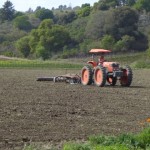 A Healthy Promise!
A Healthy Promise!
When I drive Elisa, our daughter, to school in the morning I get a glimpse of the kind of things she pays attention to as we make the 20 minute drive through the back-roads of Watsonville, Corralitos, and Aptos to avoid the stop and go traffic on HWY 1. Her curiosity often surprises me as she comes up with questions about the farming activities she sees along the way. Just the other day the plastic hoop-houses covering a large field of commercially grown blackberries were being removed, the blackberry bushes still lush and vigorous got mowed to the ground and plowed into the soil. She was curious why these healthy looking plants were suddenly removed. It puzzled me as well since blackberries can stay productive for many years and this was still a young patch. I told her my guess was that the farmer probably wants to plant a different crop or a different variety of blackberry that sold better. Maybe, I speculated, the farmer didn’t have enough helpers to pick all the berries. I knew these were not very interesting reasons for her, so in order to keep the conversation going I threw out the idea that maybe the farmer wants to raise horses and was putting in a pasture. It immediately got her attention, knowing her passion for horses.
Ever since she begged us to let her ride a horse 3 years ago, she hasn’t stopped riding and her passion has only increased. If it was up to her, I am sure, she wouldn’t mind seeing the farm, at least some of it, converted into a horse farm with pastures, riding trails, and horse jumps. She’s heard me enough times saying that pasturing our chickens is a good thing for the soil. So why not horses! I am very careful making promises. When the subject comes up I jokingly tell her that maybe one day when we run out of gas and our tractors will need to be replaced with draft horses we will have horses and pastures.
For the last few weeks Elisa has been eyeing what was going to happen with that plowed up blackberry field, and so one morning on our way to school she noticed that the entire field was covered with a sheet. She asked me, ”What is that dad, looks like a sheet of water. Is that, that poison that kills everything?” I remember she asked me the same question a few years ago and I can’t help but feel some anger and frustration. It pains me to see how many conventional growers rely on poisonous and lethal soil fumigants to grow their crops. Instead of nurturing the biological health of the soil – the very foundation of our existence, we somehow can’t rid ourselves from this pesticide addiction. It doesn’t make sense, it especially doesn’t make sense to a child or to my 9 year old daughter.

A conventional farmer’s field, recently injected with methyl bromide and covered in plastic sheeting, with a wholly insubstantial warning sign at one corner!
After taking a deep breath, I explained to her that this was indeed a bad thing and that farming organically, like we do, helps nurture the soil and the life in it. Growing healthy food requires growing vibrant soils that are full of humus and alive with microorganisms.
I reassured Elisa that more and more farmers are using organic farming practices and more people want to buy organic food, so hopefully this blackberry farmer and every farmer one day will only grow crops organically.
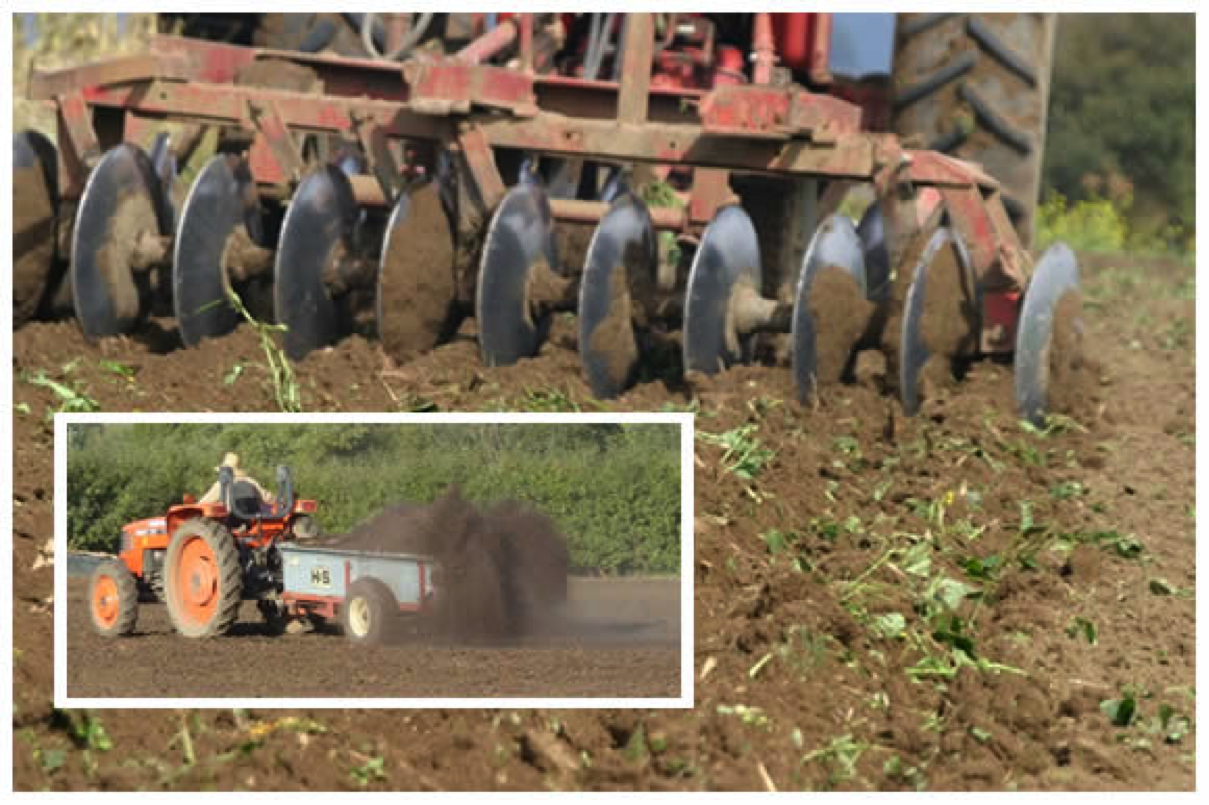
Above, our fields: the correct way, the organic way – plowing in cover crop and spreading compost.
“So”, she asked, “does that mean this farmer will not put in a horse pasture then?” “Probably not.” was all I could answer. Feeling like I couldn’t let her down, it slipped out of my mouth, “But, maybe we can on our farm.” I knew right away that she will hold me to it. It is a promise I don’t mind keeping – A happy daughter and it’s good for the Soil!
Ingredients:
1 tablespoon coconut oil
1 medium red onion, finely diced
1-2 heads cauliflower, stalks and stems removed
1 teaspoon turmeric powder
sea salt and pepper, to taste
¼ cup chopped cilantro (optional)
1/3 cup pistachios (optional)
Directions:
1. Place the cauliflower florets in a food processor and pulse until finely ground to the consistency of couscous.
2. Heat a wide, heavy sauté pan over medium heat. Add the coconut oil and the onion and sauté until the onion softens, about 5 minutes.
3. Add the cauliflower and sauté for a few minutes. Cover the pan and cook for about 5-10 minutes, stirring every so often, until the cauliflower is almost tender, but not mushy. Uncover and stir in the turmeric and season to taste. Allow the cauliflower to brown a little then turn off the heat.
4. Add the cilantro and pistachios, if using. Stir in gently to combine.
5. Transfer to a serving bowl or platter and serve.
Serves 6
Ingredients:
1 tablespoon coconut oil
1 large leek, sliced in half-moons
4 cloves garlic, minced
1 jalapeno, minced
2 medium celery stalks, diced
2 medium carrots, diced
2 cups tomatoes, pulsed to a chunky puree in a food processor
¾ teaspoon dried oregano
cayenne to taste
sea salt and pepper to taste
6 cups stock of choice, more if needed
½ cup quinoa, rinsed and drained
¾ cup peanut butter
1 large bunch collard greens, chopped into bite-sized pieces
2 tablespoons tomato paste, more if needed to thicken
lemon juice, if needed to taste
Directions:
1. Heat a large soup pot on medium heat. Add the oil, then the onion, leek, garlic, jalapeno, celery, and carrot. Sauté for a few minutes until the vegetables soften. Stir in tomato puree and spices, and season with some salt and pepper.
2. Add the stock and the quinoa. Bring to a boil, reduce heat, and cover. Simmer until quinoa is just cooked and the vegetables are tender, about 15 minutes.
3. Add the greens and peanut butter. Stir to blend in completely. Add the tomato paste and simmer for another 5 minutes. Season with salt and pepper. Taste and adjust seasonings if needed, adding lemon juice for brightness or more tomato paste. Serve!
Serves 12
Ingredients:
½-inch thick slices of French baguette
softened butter
¼-½ cup pitted Kalamata olives, minced
1-2 bunches radishes, trimmed and thinly sliced
1 bunch fresh thyme, leaves only
zest of 1 lemon
Sea salt and freshly ground black pepper
Olive oil
Directions:
1. Set the broiler rack 4 inches from the heating element.
2. Lay the bread slices on an ungreased baking sheet. Broil until the edges just turn golden brown, 1-2 minutes, watching carefully. Flip and broil the other side for 30 seconds to 1 minute. Cool to room temperature.
3. Spread each crostini with butter and top with olives and radishes. Sprinkle with thyme leaves, lemon zest, salt and pepper. Finish with a thin drizzle of olive oil.
Makes about 18 crostini (if using a half baguette)
Ingredients:
2 pounds savoy cabbage (about 1 head)
3 tablespoons butter
1 large onion, sliced
2 medium carrots, cut into ¼-inch rounds
sea salt and pepper to taste
½ cup vegetable stock, or more if needed
2 tablespoon cider vinegar
½ cup mint, chiffonade (leaves rolled together and cut into “ribbons”)
Directions:
1. Cut the cabbage into quarters and cut out the core. Chop into 1-inch pieces.
2. Heat a large, wide pan on medium heat. Add the butter, onion, carrot, and cabbage and season with salt and pepper. Sauté for a few minutes, or until the onions are translucent.
3. Add the stock and vinegar. Bring to a boil then turn heat down to a simmer and cover. Cook until almost all of the liquid is cooked away, about 45 minutes. Season again, if necessary.
4. Remove to a platter, garnish with the mint and serve.
Serves 12
Ingredients:
6 squash, trimmed
½ yellow onion
½ teaspoon sea salt
1 egg, lightly beaten
2 cloves garlic, minced
1 tablespoon flour of choice
1 tablespoon chopped fresh marjoram, of herb of choice
½ teaspoon freshly ground black pepper
1-2 tablespoons oil
Directions:
1. Shred the squash in a food processor, then the onion. In a bowl, toss the shredded squash with the salt and let stand for 5 minutes. Using your hands, squeeze the squash to remove excess liquid. Add the onion, egg, garlic, flour, herbs, and pepper to the squash. Mix well.
2. Pour about 1 tablespoon of oil into the bottom of a large frying pan to form a thin film, and place over medium-high heat. When the pan is hot, working in batches drop the squash mixture, using heaping tablespoons for each pancake. Using the back of a spoon, press on the top of each spoonful to form a pancake about a scant ½-inch thick. Fry until golden brown on the underside, 3-4 minutes. Turn and continue to fry until golden brown on the second side, 3-4 minutes longer. Transfer to a warm platter and keep warm. Repeat until all the squash mixture is used, adding more oil to the pan as needed.
Makes about 12 pancakes
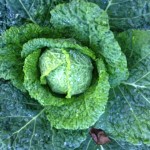 Crop & Field Notes: October 15th, 2013
Crop & Field Notes: October 15th, 2013
There are few places in the world where in the middle of October one can harvest tomatoes, peppers, summer squash, apples, strawberries, and winter squash, in addition to the large variety of greens and root crops available almost year-round. The one crop that stands out however is the mighty Brassica or Mustard family. When I did my field walk today I couldn’t help but snap pictures of this amazingly diverse and nourishing vegetable family that does so well in our coastal climate.

A new head of Savoy Cabbage
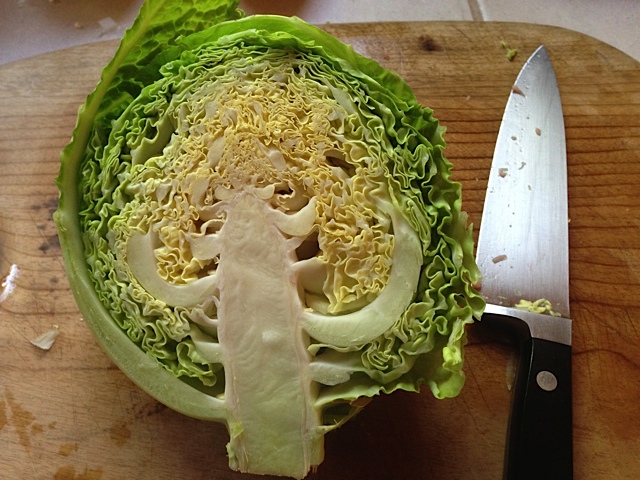
Do you see the happy man dancing in this cut-in-half head of Savoy Cabbage?

Newly formed florets of Amadeus Broccoli.
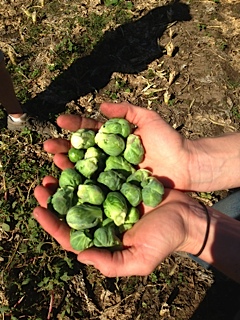
The first Brussels sprouts of the season.

Brassicas like it cool and wet. Where are the winter rains?

Pineapple Guavas have already made their way into the Extra Fruit Option.
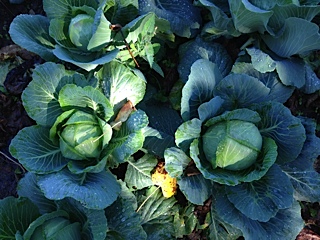
Heads of Green Cabbage forming.

A field of mixed Brassicas.
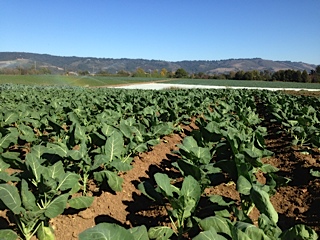
Rows of Collard Greens near the field pictured above.
Ingredients:
Dough:
2 cups diced butternut squash
3 cups vegetable broth
½ cup scallion (white and green) ( 1 bunch or 6 scallions)
1 tablespoon canned chipotle en adobo sauce
2 cloves garlic, minced
2 teaspoons sea salt
1 teaspoon ground cumin
3 cups masa harina for tamales
¾ cup olive oil
½ cup vegetable oil
Filling:
2 tablespoons olive oil
1 small bunch scallions
4 cloves garlic, minced
2 chipotle chiles in adobo, sliced
1 teaspoon ground cumin
2 teaspoons sea salt
½ cup Spanish olives with pimentos, chopped
½ cup golden raisins
¼ cup capers
1 cup vegetable stock
1 scant teaspoon grated orange zest
½ cup chopped fresh cilantro
hot sauce for serving
Prep Work:
For the dough:
1. Put butternut squash in a pot with broth, scallions, adobo sauce, garlic, salt, and cumin. Bring to a simmer and cook until squash is tender, about 15 minutes.
2. Remove squash with a slotted spoon, reserve broth. Set aside half the squash for the filling then mash the remaining squash in a large bowl.
3. Mix in the masa with a fork. Slowly pour the seasoned broth over the filling, mixing with a fork (or hands) until smooth. Slowly stir in oils, a little at a time until dough is soft and moist. Cover and set aside.
4. For the filling: Heat oil in a large skillet over medium heat. Add the scallions, garlic, chiles, cumin, and salt and cook until soft, about 1 minute.
5. Add reserved squash, olives, raisins, capers, and cook, stirring gently until well combined. Add broth and orange zest and cook, stirring occasionally until broth is slightly absorbed, about 2 minutes. Stir in cilantro., Remove from heat.
Instructions:
1. Assemble: Cut 16 strings each 8-inches long.
2. One at a time, place about ¼ of dough in center of each husk, leaving enough husk free to enclose tamale. Pat masa down. Spoon 2-3 tablespoons filling on top. Then cover filling with 2-3 tablespoons more of dough, gently patting to cover filling.
3. Wrap husks around the filling and twist and tie ends with reserved string.
4. Lay tamales in a steamer basket, cover and cook until husks get slightly transparent, about 50 minutes.
5. Remove tamales from steamer, let rest 5- 10 minutes before serving.
Makes 16 tamales
